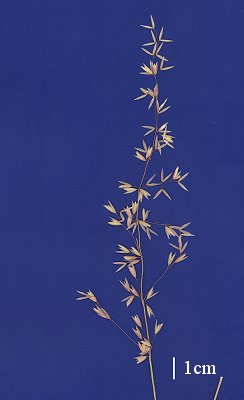 |
 |
|
 |
 |
|

Ehrharta calycina Sm. |
Common name
Perennial Veldtgrass
Derivation
Ehrharta Thunb., Kongl. Vetensk. Acad. Handl. 40: 216, Tab.8 (1779)
nom. cons.; named after Friedrich Ehrhart, a Swiss apothecary
and botanist of the eighteenth century.
calycina- from the Greek kalyx (cup) and -ina (belonging to). The subtending glumes are as long as or longer than the lemma, thereby resembling a cup.
Published in
Pl. Icon. Hactenus Ined. 2, t. 33 (1790).
Habit
Perennial, tufted. Rhizomes elongated. Stolons absent or present. Young shoots
intravaginal. Culms geniculately ascending, 30–100 cm tall. Mid-culm internodes
glabrous or pubescent. Leaf-sheath auricles present. Ligule a fringed membrane,
2 mm long, membranous, purple. Leaf-blades flat or involute or convolute, 2–250
cm long, 1–10 mm wide.
Inflorescence
Inflorescence compound, a panicle. Panicle open or contracted, linear or oblong,
equilateral or nodding, 5–25 cm long.
Spikelets
Spikelets solitary. Pedicels filiform. Fertile spikelets at least 3-flowered,
comprising 1 fertile floret, without rhachilla extension, cuneate, laterally
compressed, 4–8 mm long, breaking up at maturity. Spikelets disarticulating
below each fertile floret.
Glumes
Glumes persistent, similar, thinner than fertile lemma, gaping. Lower glume
oblong, 4–7 mm long, equalling upper glume, membranous, 7–9-nerved.
Lower glume apex erose, obtuse. Upper glume oblong, 4–7 mm long, 90%
of length of adjacent fertile lemma, membranous, 9-nerved. Upper glume apex
obtuse or acute.
Florets
Basal sterile florets 2 or more, dissimilar, without significant palea, attached
to and deciduous with the fertile. Lemma of lower sterile floret elliptic, without
auricles, 4–7 mm long, 80–90% of length of spikelet, coriaceous,
1-keeled, 5–7-nerved, smooth, villous or hispidulous, obtuse or acute,
mucronate. Lemma of upper sterile floret elliptic, basally auriculate, 4–8
mm long, 110–120% of length of lower sterile floret, coriaceous, smooth,
pilose or villous, obtuse or acute, mucronate. Fertile lemma ovate, 3.5–7.5
mm long, chartaceous, much thinner on margins, 5–7-nerved. Lemma surface
pubescent or villous. Lemma apex truncate. Palea 66% of length of lemma,
hyaline, 1–2-nerved, 1-keeled. Lodicules 2, obovate, membranous, smooth,
with a small lateral lobe. Anthers 6, 3–4 mm long.
Continental Distribution:
Africa, Australasia, South America.
Australian Distribution:
Western Australia, South Australia, New South Wales, Victoria, Tasmania.
Western Australia: Carnarvon, Eucla, Irwin, Drummond, Dale, Menzies, Warren, Eyre, Roe, Avon. South Australia: Flinders Ranges, Eyre Peninsula, Northern Lofty, Murray, Yorke Peninsula, Southern Lofty, Kangaroo Island, South-eastern. New South Wales: North Coast, Central Coast, South Coast, Central-Western Slopes, South-Western Slopes, South-Western Plains. Victoria: Murray Mallee, Lowan Mallee, Wimmera, Wannon, Grampians, Riverina, Midlands, Victorian Volcanic Plain, Otway Plain, Otway Range, Gippsland Plains, Wilsons Promontory, East Gippsland. Tasmania: Furneaux Group, North East, East Coast.
Classification. (GPWG
2001):
Ehrhartoideae: Ehrharteae
Notes
Introduced. Often in coastal areas on sandy soils.

Inflorescence (scanned specimen)
© Queensland Herbarium
AQ 533968
by D.Sharp